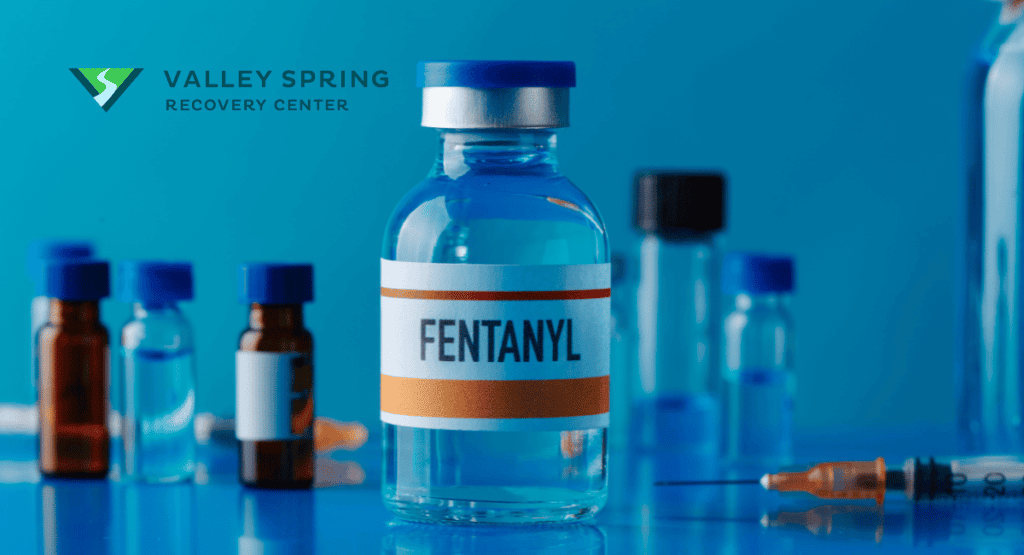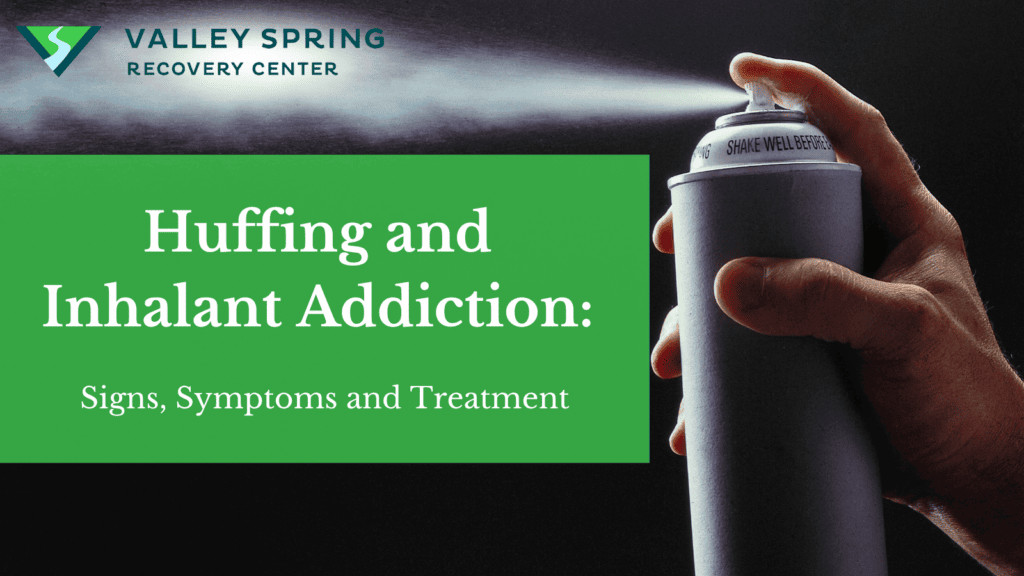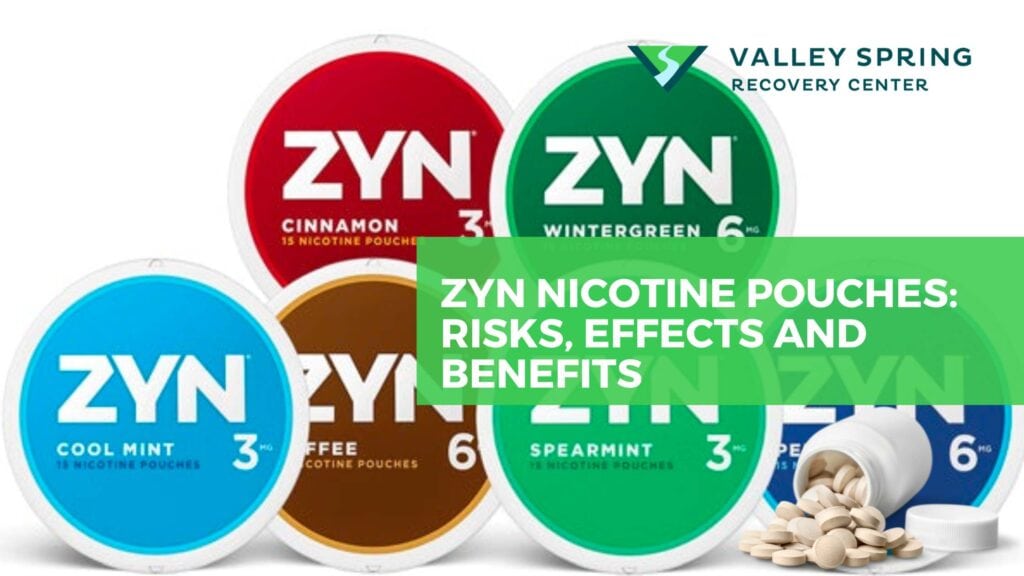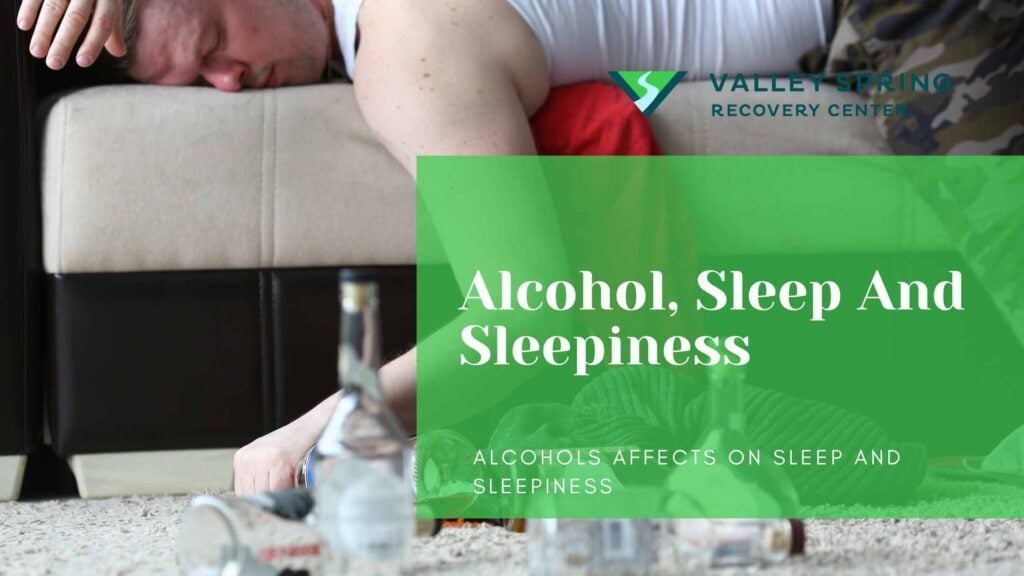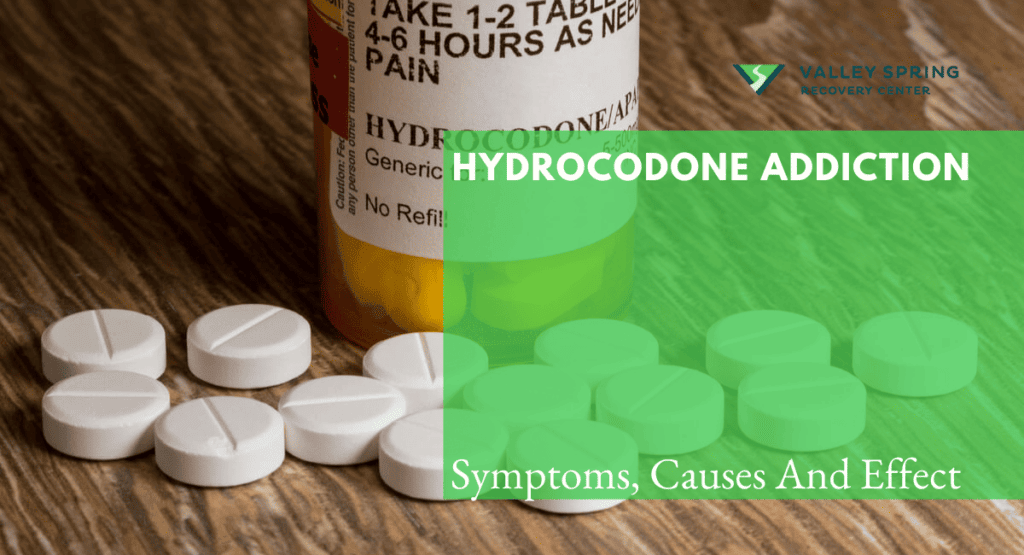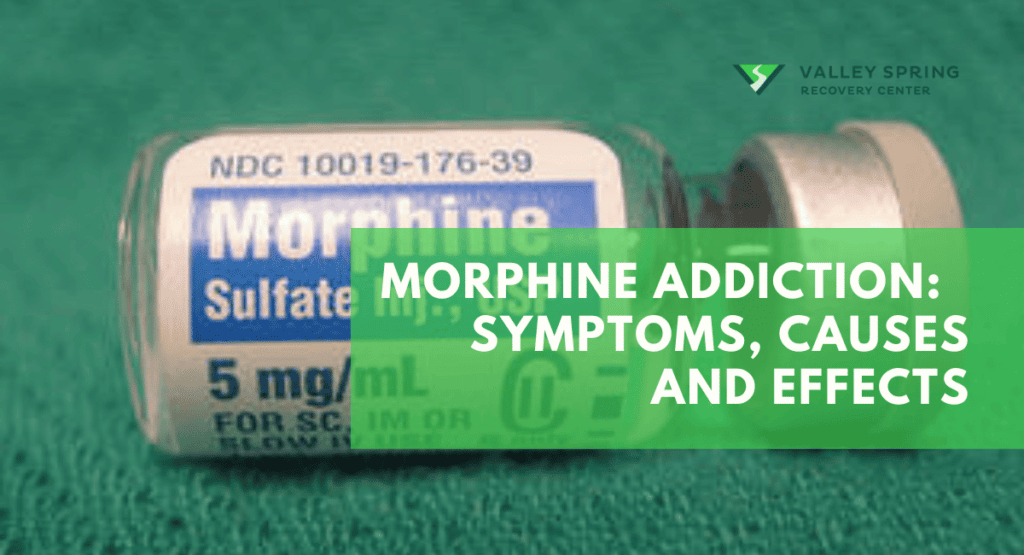Fentanyl addiction is a type of substance abuse disorder characterized by the compulsive and excessive use of the opioid drug, fentanyl. Fentanyl is a potent synthetic opioid used medically for pain management but is also associated with a growing addiction crisis. This problematic usage disrupts various aspects of an individual’s life and can have multiple detrimental effects. There are specific signs that can help identify the presence of fentanyl addiction in a person.
Symptoms of fentanyl addiction may include withdrawal symptoms when not using the drug, increasing dependence on fentanyl as a way to cope with emotional or physical pain, and negative repercussions on personal and professional life, among others. Several factors contribute to the onset of this addiction.
The causes of fentanyl addiction encompass biological predispositions, emotional stressors, and mental health conditions. These elements compel an individual to persist in the excessive use of fentanyl, often as a way to alleviate uncomfortable feelings. The chronic misuse of fentanyl can lead to a host of health issues and interpersonal problems commonly associated with other forms of addiction.
The effects of fentanyl addiction can range from mental health disorders like anxiety or depression, social isolation, reduced physical well-being, diminished self-esteem, and poor performance in work or educational settings, among other issues.
What is Fentanyl?
Fentanyl is a powerful synthetic opioid analgesic that is used medically for pain management in cases of surgery or cancer treatment. Fentanyl is up to 50 times stronger than heroin and 100 times stronger than morphine. It is a major contributor to fatal and nonfatal overdoses. (CDC)
Fentanyl is also illegally manufactured and sold on the black market, contributing to the opioid epidemic due to its high potency and potential for addiction and overdose.
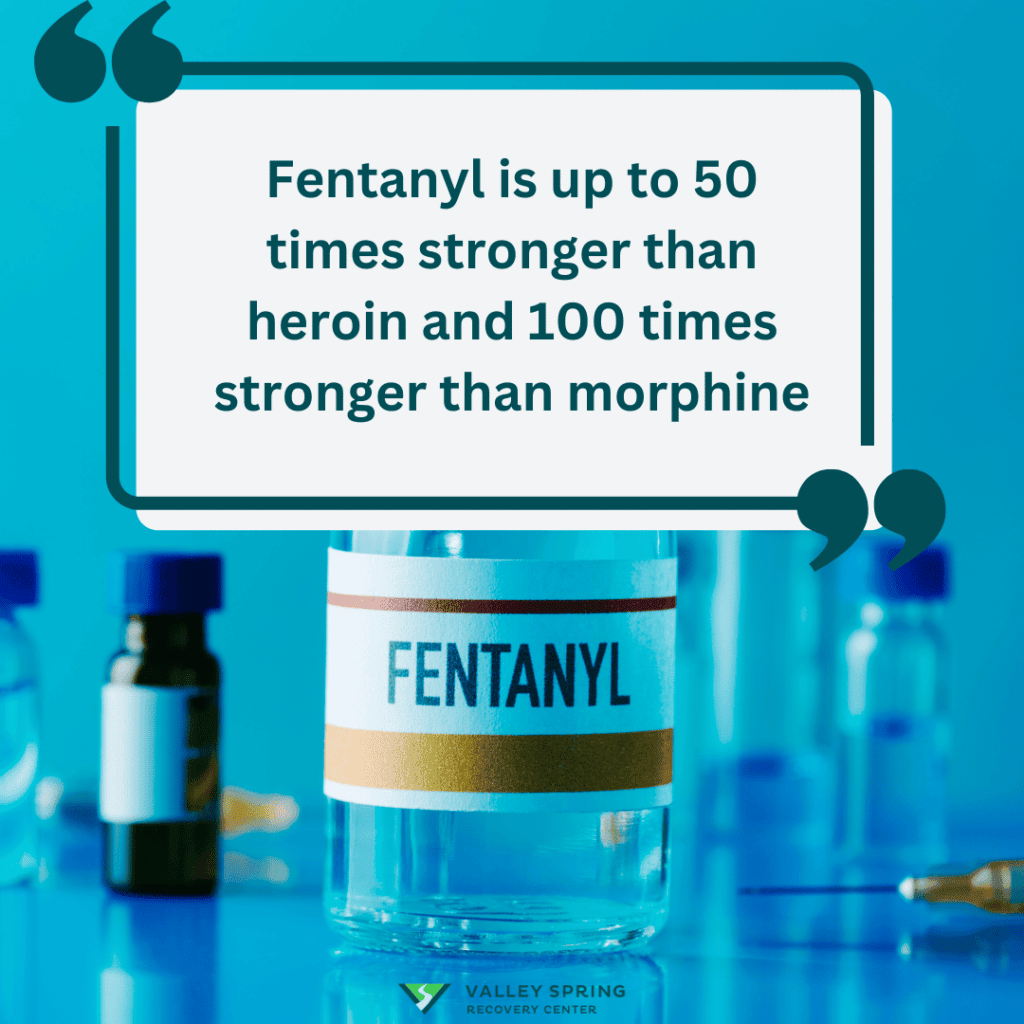
What Are The Signs of Fentanyl Addiction?
The symptoms of Fentanyl addiction encompass a range of physical, behavioral, and emotional indicators that collectively underscore the growing crisis of opioid dependency driven by this powerful synthetic opioid. Here are signs and symptoms that can aid in recognizing Fentanyl addiction:
- Increased Tolerance: Needing higher doses of Fentanyl to achieve the same effects.
- Withdrawal Symptoms: Experiencing discomfort when not using Fentanyl, such as anxiety, restlessness, muscle aches, and nausea.
- Preoccupation: Constantly thinking about obtaining and using Fentanyl.
- Neglecting Responsibilities: Failing to meet work, school, or family obligations due to Fentanyl use.
- Loss of Interest: Losing interest in previously enjoyed activities.
- Social Isolation: Withdrawing from friends and family to use Fentanyl in secrecy.
- Financial Problems: Spending significant money on acquiring Fentanyl, often at the expense of other needs.
- Legal Issues: Engaging in illegal activities to obtain Fentanyl or facing legal consequences due to drug-related actions.
- Health Problems: Experiencing physical and mental health issues related to Fentanyl use, such as respiratory problems or mood disturbances.
- Failed Attempts to Quit: Trying to stop or cut down on Fentanyl use unsuccessfully.
- Continued Use Despite Consequences: Using Fentanyl even when aware of its negative impact on health, relationships, or life circumstances.
Recognizing these signs and symptoms early can be crucial for seeking help and initiating effective treatment for Fentanyl addiction.
Physical Signs
- Pinpoint pupils
- Drowsiness
- Slurred speech
- Nausea and vomiting
- Shallow breathing
- Itchiness and scratching
- Frequent nodding off or falling asleep
- Track marks or injection sites on the skin
- Weight loss and malnutrition
- Poor hygiene
Behavioral Signs
- Social withdrawal
- Changes in social circles
- Neglecting responsibilities
- Lying or being secretive about drug use
- Engaging in risky behaviors to obtain Fentanyl
- Rapid mood swings
- Loss of interest in hobbies and activities
- Legal problems related to drug use
- Financial difficulties
- Continued drug use despite negative consequences
Emotional Signs
- Mood swings
- Anxiety
- Depression
- Irritability
- Emotional numbness
- Feelings of guilt or shame
- Low self-esteem
- Agitation
- Paranoia
- Apathy
Early Symptoms
- Increased tolerance
- Occasional recreational use
- Seeking out the drug more frequently
- Using Fentanyl to cope with stress or pain
- Social and recreational activities centered around the drug
Advanced Symptoms
- Physical and psychological dependence
- Inability to control or stop Fentanyl use
- Severe withdrawal symptoms when not using
- Decline in physical and mental health
- Neglect of personal and professional responsibilities
- Financial, legal, and interpersonal problems
- Risk of overdose and life-threatening complications
- Isolation from friends and family
- Drastic changes in appearance and hygiene
- Loss of interest in activities unrelated to drug use
What Are The Causes of Fentanyl Addiction?
Fentanyl addiction is a complex issue that has been gaining increasing attention in the healthcare sector. Understanding the specific factors that contribute to this form of addiction is not only crucial for prevention but also for effective treatment.
Biological Factors: Genetic predisposition plays a significant role in fentanyl addiction. Individuals with a family history of substance abuse are often more susceptible due to certain genes that influence neurotransmitter levels, making them more prone to addiction. Additionally, the brain chemistry involved in fentanyl use is another biological factor. Fentanyl interacts with opioid receptors in the brain, leading to an increased release of dopamine. This surge in dopamine creates a euphoric feeling, which the brain starts to crave, thereby leading to addiction.
Psychological Factors: Psychological elements also contribute to fentanyl addiction. Emotional pain, often stemming from traumas or distressing life events, can drive individuals to seek escape through substances like fentanyl. The drug provides temporary relief from emotional suffering, making it an attractive but dangerous coping mechanism. Moreover, mental health disorders such as depression, anxiety, and PTSD can make individuals more susceptible to addiction as fentanyl use can be a form of self-medication, even though it worsens the condition over time.
Environmental Factors: The environment in which an individual resides can be a potent catalyst for fentanyl addiction. Peer pressure, especially within social circles that normalize drug use, can significantly influence an individual to try fentanyl. The need for social acceptance and belonging can make people more susceptible to experimenting with and subsequently abusing the drug. Accessibility is another environmental factor; the easier it is to obtain fentanyl, the higher the likelihood of addiction. Reduced barriers to access lead to increased usage and, consequently, a higher risk of addiction.
Medical Factors: Medical reasons can also lead to fentanyl addiction. The drug is often prescribed for pain relief following surgeries or for managing chronic pain conditions. Inadequate monitoring and over-prescription can quickly lead to dependency and, eventually, addiction. Furthermore, tolerance to fentanyl can build up over time, requiring the individual to consume higher doses to achieve the same effects, thereby creating a vicious cycle of abuse and addiction.
What Are The Effects of Fentanyl?
The effects of fentanyl revolve around how addictive the substance is which forms a strong dependency, forcing addicts to prioritize fentanyl use over all of the other responsibilities in their life. The concept of dependency revolves around the physiological and psychological reliance on a substance, behavior, or activity, where the individual experiences a compelling need for it to function normally, often leading to detrimental consequences.
Short-Term Effects of Fentanyl Dependency:
- Euphoria
- Drowsiness
- Confusion
- Nausea and vomiting
- Slurred speech
- Constipation
- Respiratory depression
- Pinpoint pupils
- Itchiness and sweating
- Increased risk of overdose
Long-Term Effects of Fentanyl Dependency:
- Increased tolerance
- Physical and psychological dependence
- Chronic respiratory issues
- Weakened immune system
- Cognitive impairment
- Social and interpersonal problems
- Financial and legal issues
- Risk of overdose and death
- Health complications, such as heart problems
- Decline in overall quality of life
- Pain Relief
- Euphoria and Relaxation
- Depression of the Central Nervous System
- Respiratory Depression
- Physical Dependence and Tolerance
- Withdrawal Symptoms
- Risk of Addiction
How Common Is Fentanyl Addiction?
The prevalence of Fentanyl addiction has surged in recent years, posing a critical public health challenge due to the drug’s extreme potency and alarming rates of overdose fatalities.
Global statistics on Fentanyl addiction indicated a concerning trend, with a significant increase in overdose deaths and addiction cases in various countries, particularly the United States and Canada, highlighting the urgent need for comprehensive strategies to address this growing crisis.
Overdose Deaths: Fentanyl has been a major contributor to the opioid overdose crisis in the United States In 2020, there were approximately 93,000 drug overdose deaths in the U.S., with Fentanyl and its analogs being involved in a significant portion of these cases according to Trends in U.S. Drug Overdose Deaths (1999 – 2021) report by the U.S. Department of Health and Human Services. NIDA’s Fentanyl Drug Facts publication from 2021 also stated Fentanyl and other synthetic opioids are the most common drugs involved in overdose deaths
Increase in Fentanyl-Related Deaths: The number of Fentanyl-related deaths has been on the rise, driven by the illicit manufacturing and distribution of the drug. This trend has been a cause for great concern among public health officials. In New Jersey Alone fentanyl overdose deaths have nearly doubled since 2016.
Geographic Variations: Fentanyl addiction and overdose rates have shown geographic variations, with certain states and regions experiencing a higher prevalence of Fentanyl-related problems than others according to NIDA in their Fentanyl DrugFacts research from 1 Jun. 2021.
What Is The Science Behind Fentanyl Addiction?
The science behind Fentanyl addiction delves into the intricate neurological mechanisms by which this potent synthetic opioid alters brain chemistry, leading to the development of physical and psychological dependence.
Fentanyl affects the brain by binding to opioid receptors, primarily the mu-opioid receptors, which are located throughout the central nervous system. When Fentanyl binds to these receptors, it produces a cascade of effects, including:
When Did The Fentanyl Epidemic Start?
Fentanyl was first synthesized by Dr. Paul Janssen in Belgium in the early 1960s. It was initially introduced as an intravenous anesthetic under the brand name “Sublimaze.” Over the years, its use expanded to include pain management, particularly for patients with severe or chronic pain.
The drug gained popularity in the medical field due to its potency and effectiveness in relieving pain. Pharmaceutical companies developed various formulations, including patches, lozenges, and injectables, to provide controlled and sustained pain relief.
However, Fentanyl’s history is also marked by its misuse and illegal production. Illicitly manufactured Fentanyl began to appear in the 1970s, leading to cases of overdose and addiction. This trend escalated in the late 20th and early 21st centuries, contributing to the opioid epidemic in many countries.
How is Fentanyl Consumed?
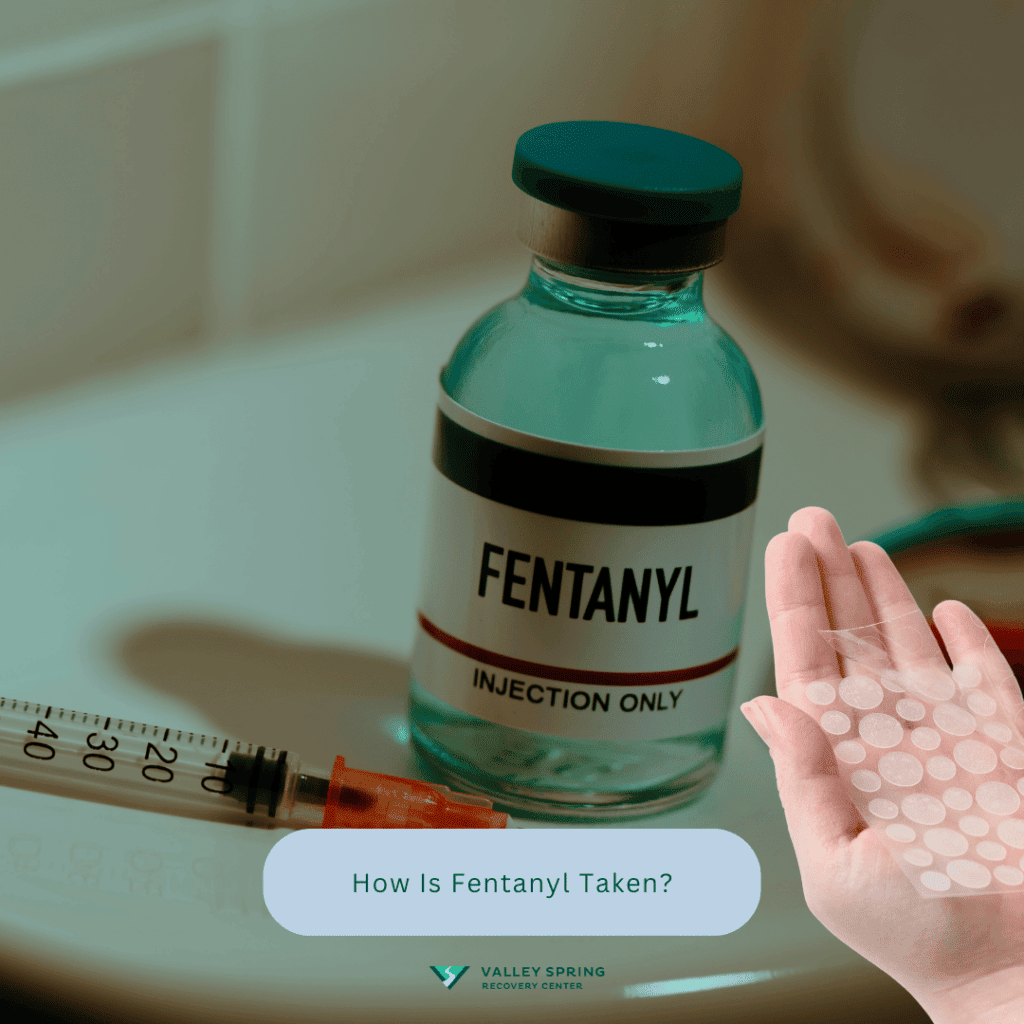
- Medical use:
- Intravenous (IV): Fentanyl is administered directly into the bloodstream through a vein. This method allows for rapid pain relief and is often used in surgical settings.
- Transdermal Patches: Medically prescribed Fentanyl patches are applied to the skin. They release a controlled amount of the drug over an extended period, typically lasting 48 to 72 hours.
- Lozenges or Lollipops: Fentanyl can be prescribed in the form of lozenges (also known as “Actiq”) or lollipops (brand name “Fentora”) for breakthrough cancer pain.
- Nasal Spray: There are Fentanyl nasal sprays, such as “Lazanda,” designed for quick absorption through the nasal mucosa.
- Illicit use:
- Smoking: Illicitly manufactured Fentanyl may be smoked by heating the drug on foil and inhaling the vapors.
- Snorting: Some individuals crush Fentanyl pills or powder and snort it through the nose, allowing for rapid absorption through the mucous membranes.
- Injection: Illicit Fentanyl can be dissolved in a liquid and injected intravenously, similar to medical use but without a prescription.
- Oral Ingestion: In some cases, individuals may swallow Fentanyl pills or powder, although this method is less common due to slower onset.
It’s crucial to understand that the misuse of Fentanyl, especially in non-medical and high doses, can lead to overdose and life-threatening consequences due to its profound impact on the brain and body.
What Happens When You Stop Using Fentanyl?
When you stop using Fentanyl you will experience withdrawal which can be extremely challenging due to the drug’s potency and the severity of withdrawal symptoms. Some of the withdrawal challenges associated with Fentanyl addiction include:
- Intense Cravings: Fentanyl withdrawal often leads to powerful cravings for the drug, making it difficult for individuals to resist using it again.
- Severe Physical Symptoms: Withdrawal from Fentanyl can cause severe physical discomfort, including muscle aches, joint pain, nausea, vomiting, diarrhea, and abdominal cramping.
- Emotional Distress: Emotional withdrawal symptoms are common and can include anxiety, depression, irritability, and intense mood swings, which can be overwhelming.
- Insomnia: Difficulty sleeping is a frequent withdrawal symptom, leading to fatigue and exacerbating emotional distress.
- Flu-Like Symptoms: Some individuals experience flu-like symptoms during Fentanyl withdrawal, such as chills, sweating, runny nose, and fever.
- Increased Sensitivity to Pain: Withdrawal can heighten the perception of pain, which can be especially distressing for individuals who initially used Fentanyl for pain management.
- Risk of Relapse: The severity of Fentanyl withdrawal symptoms can drive individuals to relapse, as they may use the drug to alleviate the discomfort.
- Protracted Withdrawal: Fentanyl withdrawal can be prolonged, with symptoms persisting for an extended period, contributing to the challenges of recovery.
Due to the potential severity of Fentanyl withdrawal and the risk of relapse, it’s crucial for individuals seeking recovery to do so under the guidance of medical professionals.
What Are The Statistics on Fentanyl Addiction?
The statistics on Fentanyl addiction provide a sobering insight into the escalating public health crisis surrounding this potent synthetic opioid, revealing a disturbing rise in overdose deaths and addiction rates that necessitate urgent attention and intervention.
Admission Rates
Admission Rates by Gender:
Fentanyl addiction admission rates have historically shown gender disparities. In many cases, men have had higher admission rates than women.
However, it’s important to note that addiction patterns can vary by region and over time, and gender disparities may change accordingly.
Admission Rates by Age Groups:
Admission rates for Fentanyl addiction can vary significantly across age groups. Historically, younger adults, particularly those in their 20s and 30s, have shown higher rates of admission for opioid addiction, including Fentanyl.
However, Fentanyl addiction has also affected older age groups, including those over 50, due to its presence in prescription medications and illegal drug markets.
Keep in mind that the dynamics of addiction and admission rates can change over time, and new data may provide a more current picture of the situation.
Relapse Rates
Short-term Relapse Rates:
- In the short term, relapse rates for Fentanyl addiction can be relatively high. The intense withdrawal symptoms and cravings associated with Fentanyl can make it difficult for individuals to stay clean without appropriate support and treatment.
- Detoxification, which is the initial step in addiction treatment, can help individuals get through the acute withdrawal phase. However, without follow-up treatment and support, relapse is more likely.
Long-term Relapse Rates:
- Long-term relapse rates for Fentanyl addiction can also be significant. Addiction is a chronic condition, and managing it over the long term often requires ongoing treatment, therapy, and support.
- Factors that contribute to long-term relapse include the highly addictive nature of Fentanyl, the risk of returning to drug use during times of stress or exposure to triggers, and the potential for overdose, which is particularly high with Fentanyl.
- Engaging in comprehensive treatment programs that include therapy, counseling, and support groups can improve long-term recovery outcomes. However, relapse remains a risk for many individuals.
Mortality Rates
- Rising Overdose Deaths: In many regions, there has been a sharp increase in overdose deaths related to Fentanyl. This surge is often attributed to the illicit production and distribution of Fentanyl, which is frequently mixed with other drugs like heroin or counterfeit prescription pills.
- Potency and Lethality: Fentanyl is estimated to be 50 to 100 times more potent than morphine and about 50 times more potent than heroin. This extreme potency makes it easy to overdose accidentally, even for individuals with a tolerance to opioids.
- Polydrug Use: Many Fentanyl-related deaths involve the use of multiple substances, which can increase the risk of overdose. When Fentanyl is combined with other drugs, such as benzodiazepines or alcohol, the risk of a fatal overdose is amplified.
- Naloxone: The opioid overdose reversal drug naloxone (Narcan) can be a lifesaver in cases of Fentanyl overdose. Widespread distribution and training on how to use naloxone have been crucial in preventing some overdose deaths.
- Regional Variations: Mortality rates related to Fentanyl addiction and overdose vary by region, and some areas have been harder hit than others. Availability and purity of illicit Fentanyl can vary widely.
- Public Health Crisis: The opioid crisis, driven in part by Fentanyl, has been declared a public health emergency in many countries, including the United States and Canada. Efforts to combat this crisis include increased access to addiction treatment, harm reduction strategies, and law enforcement efforts targeting illicit drug production and distribution.
Contributing Factors:
- Illicit Production and Distribution: Illicitly manufactured Fentanyl is often produced in clandestine labs and mixed with other drugs, making it difficult for users to know the potency and contents of the substances they are consuming. This increases the risk of overdose.
- High Potency: Fentanyl is an extremely potent opioid, which means that even a small amount can have a powerful effect. Its potency makes it more likely for users to overdose accidentally.
- Accessibility: Fentanyl and its analogs are relatively easy to obtain on the black market, either through illegal drug dealers or online sources, which contributes to its widespread availability.
- Economic Factors: Some individuals turn to Fentanyl because it can be cheaper than prescription opioids or other drugs. Economic hardship can drive people toward more affordable and accessible substances.
- Prescription Opioid Misuse: Some individuals initially become addicted to prescription opioids, and when their access to these medications is restricted, they may turn to Fentanyl or other illicit opioids as a substitute.
- Lack of Treatment Access: Insufficient access to addiction treatment and mental health services can hinder individuals from getting the help they need to overcome Fentanyl addiction.
- Stigma: Stigma associated with addiction can deter individuals from seeking help or disclosing their struggles, leading to a lack of early intervention.
- Co-occurring Mental Health Issues: Many individuals with Fentanyl addiction also struggle with co-occurring mental health disorders. Untreated mental health issues can contribute to the development and persistence of addiction.
- Polydrug Use: Mixing Fentanyl with other substances, such as alcohol, benzodiazepines, or cocaine, is common but highly dangerous and increases the risk of overdose.
- Social and Environmental Factors: Social and environmental factors, such as peer pressure, trauma, and adverse childhood experiences, can contribute to substance abuse and addiction, including Fentanyl addiction.
What Are The Treatment Options For Fentanyl Addiction?
Treatment options for Fentanyl addiction encompass a range of approaches designed to address the physical, psychological, and social aspects of addiction.
Inpatient Treatment
What it Involves:
- Structured Environment: Inpatient treatment provides a highly structured and controlled environment, minimizing exposure to triggers and temptations associated with drug use.
- Detoxification: The first phase of inpatient treatment often involves medically supervised detoxification to safely manage withdrawal symptoms.
- Individual and Group Therapy: Patients participate in individual counseling sessions and group therapy to address the psychological aspects of addiction, learn coping strategies, and gain insight into the root causes of their substance abuse.
- Medication-Assisted Treatment (MAT): Depending on the facility and the individual’s needs, MAT may be incorporated, which can help reduce cravings and prevent relapse.
- Educational Workshops: Patients may attend educational workshops on addiction, relapse prevention, and life skills.
- Peer Support: Interaction with peers who are also in recovery can provide valuable support and a sense of community.
- Holistic Approaches: Some inpatient programs incorporate holistic therapies, such as mindfulness, yoga, and art therapy, to promote overall well-being.
- Aftercare Planning: A successful inpatient program will include comprehensive aftercare planning, which can involve outpatient therapy, support groups, and ongoing relapse prevention strategies.
The success rates of inpatient treatment for Fentanyl addiction can vary widely depending on several factors, including the individual’s commitment to recovery, the quality of the treatment program, and the presence of co-occurring mental health issues. Success is often measured by sustained abstinence from Fentanyl and improved overall well-being.
Outpatient Treatment
What it Involves:
- Counseling and Therapy: Outpatient treatment typically includes individual and group counseling sessions focused on addiction recovery, coping skills, and relapse prevention.
- Medication-Assisted Treatment (MAT): Some outpatient programs offer MAT to help manage cravings and withdrawal symptoms, especially for opioids like Fentanyl.
- Flexibility: Outpatient programs offer greater flexibility compared to inpatient care, allowing individuals to continue with work, school, or family responsibilities while receiving treatment.
- Frequency of Sessions: The frequency of outpatient sessions varies but can range from weekly to several times per week, depending on the individual’s needs and the program’s intensity.
- Support Groups: Outpatient programs may encourage participation in support groups, such as 12-step programs or SMART Recovery, to enhance peer support.
- Education: Educational components may include information on addiction, its effects, and strategies for long-term recovery.
- Regular Assessments: Patients undergo regular assessments to track progress and adjust treatment plans accordingly.
- Aftercare Planning: Like inpatient treatment, outpatient programs often involve aftercare planning to ensure individuals have ongoing support and resources after completing the program.
Success Rates:
- Lower Intensity, Lower Success Rates: Outpatient treatment may have slightly lower success rates compared to inpatient treatment, primarily because it offers less intensive supervision and structure.
- Effectiveness for the Right Candidates: Outpatient treatment can be highly effective for individuals with mild to moderate addiction, a stable home environment, and a strong support system.
- Long-Term Commitment: Success often depends on the individual’s long-term commitment to recovery, including ongoing engagement in therapy, support groups, and relapse prevention efforts.
- Customized Care: Success rates can be improved when outpatient programs are tailored to the individual’s needs, providing the appropriate level of care and support.
It’s crucial to recognize that what works best for one person may not work as effectively for another.
What Are The Harm Reduction Strategies For Fentanyl Addiction?
Harm reduction strategies for Fentanyl addiction aim to minimize the negative consequences of drug use while promoting safety and well-being. Two important harm reduction approaches for Fentanyl addiction are needle exchange programs and medication-assisted treatment (MAT):
Needle exchange programs provide clean, sterile needles and syringes to individuals who use Fentanyl or other drugs via injection. The primary goal is to reduce the transmission of bloodborne diseases like HIV and hepatitis C among drug users.
- Distribution of sterile needles and syringes.
- Safe disposal of used needles to prevent accidental injuries.
- Education and counseling on safer injection practices.
- Referrals to addiction treatment and other health services.
MAT combines medications with counseling and behavioral therapies to treat addiction. For Fentanyl addiction, MAT often involves medications like methadone, buprenorphine, or naltrexone.
- Medication to reduce cravings and withdrawal symptoms.
- Counseling and therapy to address the psychological aspects of addiction.
- Medical monitoring and support to ensure safe and effective treatment.
What Is The Importance of Support Systems For Fentanyl Addicts?
Support systems are paramount when navigating Fentanyl addiction, providing crucial emotional, practical, and motivational assistance. They offer a lifeline during the often challenging journey of recovery, helping individuals cope with cravings, manage triggers, and sustain motivation for lasting change.
Whether from family, friends, support groups, or healthcare professionals, these support networks foster a sense of connection and understanding, significantly increasing the likelihood of successful recovery from Fentanyl addiction.
Final Thoughts On Fentanyl Addiction
Fentanyl addiction is a severe and life-threatening condition that requires urgent attention and comprehensive treatment.
Its potency and the risk of overdose make it exceptionally dangerous, but recovery is possible with the right support, including medical treatment, therapy, and a strong support network.
Early intervention, harm reduction strategies, and public awareness are essential in addressing the Fentanyl crisis and saving lives.
Sources
https://www.hhs.gov/overdose-prevention/
https://nida.nih.gov/publications/drugfacts/fentanyl/
Kristy Ashe
All author postsShare This Post

